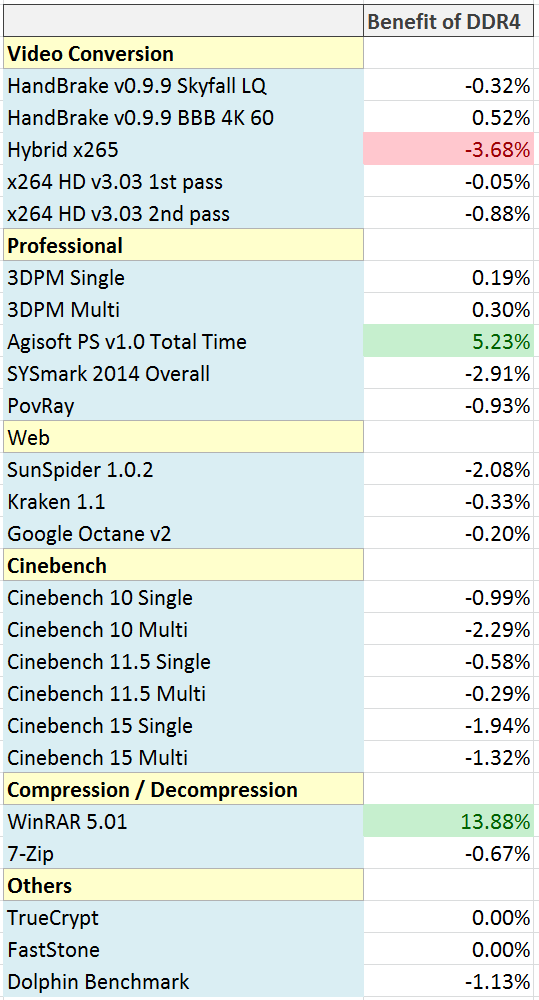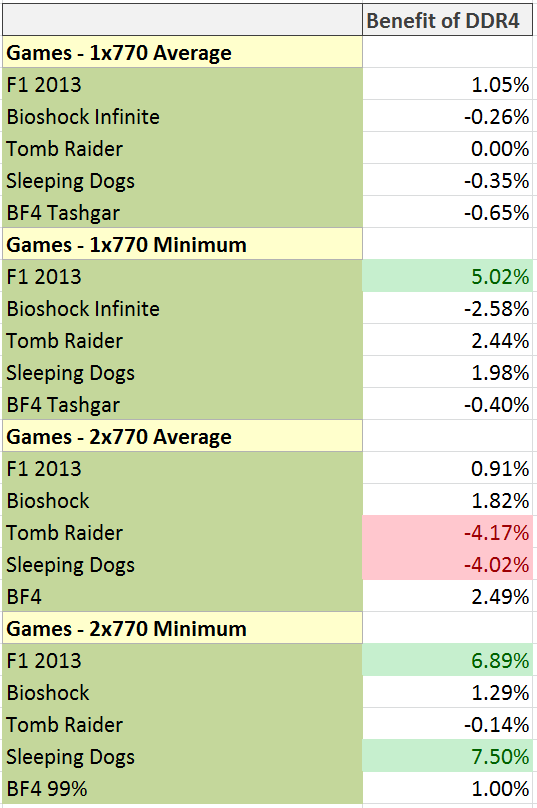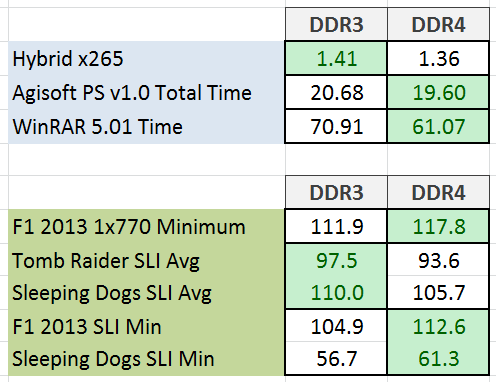DDR4 Haswell-E Scaling Review: 2133 to 3200 with G.Skill, Corsair, ADATA and Crucial
by Ian Cutress on February 5, 2015 10:10 AM ESTComparing DDR3 to DDR4
Moving from a standard DDR3-2133 C11 kit to DDR4-2133 C15, just by looking at the numbers, feels like a downgrade despite what the rest of the system is. Ideally we want the first number, the frequency, to be high and the second number, the latency, to be low. After spending several years dealing with DDR3, moving to DDR4 feels a bit of a backwards step when you look at solely the numbers on paper.
As part of this review we have covered many different areas where DDR4 is the upgrade of DDR3, not only in terms of voltage but some of the underlying concepts as well. This puts DDR4 in a position for upgradability in the future, especially when it comes to density and future technologies (see the next page for more information). But an ultimate question still remains: at the same frequency and latency, do they perform the same?
The only way to perform an identical comparison would be to have a platform that could probe both DDR3 and DDR4 while keeping the same CPU. If one comes along, we will test that, but in the mean time we can do some broad comparisons with near-identical systems.
For this test we took two Haswell based systems and compared them against each other. The first contains the Haswell-E i7-5960X processor, cut it down to run at four cores with no HyperThreading, fixed the CPU speed at 4 GHz and placed the memory into DDR4-2133 14-14-14 350 2T timings. We did the same with the second system, a Haswell based i7-4770K moved it to 4 GHz and making sure it was in 4C/4T mode. The OS was placed into a unique high performance profile and we ran our test suite. The only difference that remained between the two setups was the L2 and L3 cache, which we cannot change unfortunately.
In our non-gaming tests, there is one situation where DDR3 is more than 3% better and two where DDR4 is +3%. It is worth noting that most of the numbers, especially with things like the Web and Cinebench are actually slightly negative.
In the gaming tests, similarly there are more +3% on the side of DDR4. If we do a direct comparison regardless of the percentage, DDR4 wins 11 times compared to DDR3 getting 8, and almost of DDR3’s wins are minor except for two-way SLI. It would seem that for two-way SLI DDR4 at least brings up some of the minimum frame rates.
Pulling out the >3% difference numbers, just to see what the numbers exactly are:
On the face of it, the Hybrid result does not seem that different, whereas a full minute on Photoscan or 10 seconds in our WinRAR test feels like a difference. In the gaming tests moving nearer to 120 FPS or 60 FPS, especially in both of the minimum frame rate tests, is an important jump which happens with DDR4.
Overall, comparing DDR4 to DDR3, there is little difference to separate the two. In a couple of small instances one is better than the other, but on those edge cases it might be prudent to say that we cannot make a final decision until we can synchronize the rest of the system, such as the size of CPU caches. When we can perform such tests, we will run some more numbers.













120 Comments
View All Comments
menting - Friday, February 6, 2015 - link
simulation software, pattern recognition, anything that does a lot of data analysis and/or data transformation. Heck, whatever an SSD's BW is good for, high BW memory can also be good forretrospooty - Sunday, February 8, 2015 - link
Simulation and pat rec maybe, not that anyone uses it other than rare outliers... But Anything an SSD is good for? No, not at all. An SSD improves launch times for anything and everything from browsers to office apps, to graphic suite apps like Adobe CS to games. Everything that normal people do. HB ram improves almost zero for the vast majority of what people actually do with computers. Even what enthusiasts do.menting - Monday, February 9, 2015 - link
"SSD improves launch times for anything and everything from browsers to office apps, to graphic suite apps like Adobe CS to games. Everything that normal people do". Exactly my point. Everything that normal people do. All that an SSD does is to provide faster storage (granted, it's non-dynamic storage, unlike DRAM) such that when a CPU can't find the data in the cache nor the DRAM, it can go to it for data. If you have enough DRAM, all these software can reside in DRAM (provided that power does not go out). Also, a smart algorithm will know what software you used before so it will keep some parts in memory so the next time you launch it it will be faster. And the speed that it can relaunch will heavily depend on DRAM BW.If you want to talk about rare outliers, people who are serious enough Adobe users or gamers who really get affected in a major way by using a SSD vs a traditional HD are rare outliers. I won't be surprised if the number of those people are on par or lower than people that use simulation software or pattern recognition software.
BTW, if memory BW doesn't make much of a difference, why do graphic cards go for GDDRx instead of plain DDRx?
retrospooty - Monday, February 9, 2015 - link
"BTW, if memory BW doesn't make much of a difference, why do graphic cards go for GDDRx instead of plain DDRx?"You are seriously clouding the issue here. With a graphics card assuming you are utilizing it with a modern 3d game or such, would benefit immensely from memory bandwidth on the card... It hardly benefits at all from system RAM bandwidth. Like everything, memory bandwidth doubling while timing/latency more than doubles doesn't improve system performance much at all. Some cases ahve it diminishing performance. This is NOT about Video RAM, its system RAM and based on the Intel CPU architecture for the past 15+ years, improving memory bandwidth at the cost of latency doesn't help much...
AGAIN, as I said in my original post - "We saw almost no improvement going from DDR400 cas2 to DDR3-1600 CAS10 now the same to DDR4 3000+ CAS [rediculous]
menting - Tuesday, February 10, 2015 - link
if you just want to talk about system RAM, the biggest blame is on software and CPU architecture, since with the exception of a few, are not optimized to take advantage of BW, only latency, even when the usage condition is ripe for doing so.retrospooty - Wednesday, February 11, 2015 - link
This is an article about system RAM. Why would anyone be talking about video RAM? Agreed, it is a CPU architecture issue, however this is the world we live in and this is the CPU architecture we have... Intel is pretty much the top of the heap.FlushedBubblyJock - Sunday, February 15, 2015 - link
Don't worry there are endless thousands of bonerheads who cannot wait to be "sporting" DDR4.For most, if they are made to think it should be faster, it is, no matter what occurs in reality.
I'd say 75% of it is how happy hyped their mental attitude is about how awesome their new bonerhead equipment is marketed to be, including any errors and rumors about what it is they actually purchased and installed, which they in many cases are not clear on.
xTRICKYxx - Thursday, February 5, 2015 - link
This would be an interesting topic to return to when DDR4 becomes mainstream with higher speeds.WaitingForNehalem - Thursday, February 5, 2015 - link
Now this is an excellent article. Thank you!ExarKun333 - Thursday, February 5, 2015 - link
AMAZING article! Been waiting for this! :)